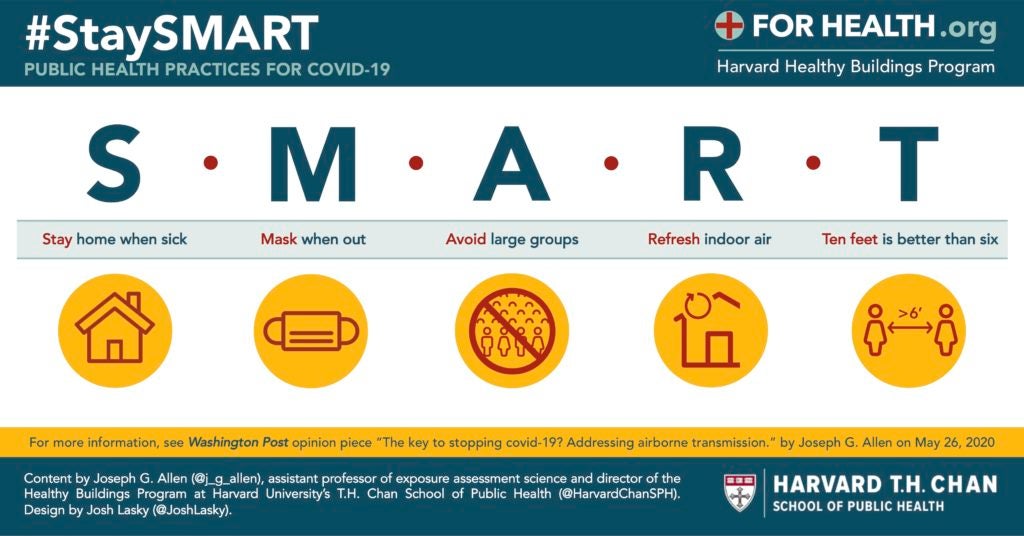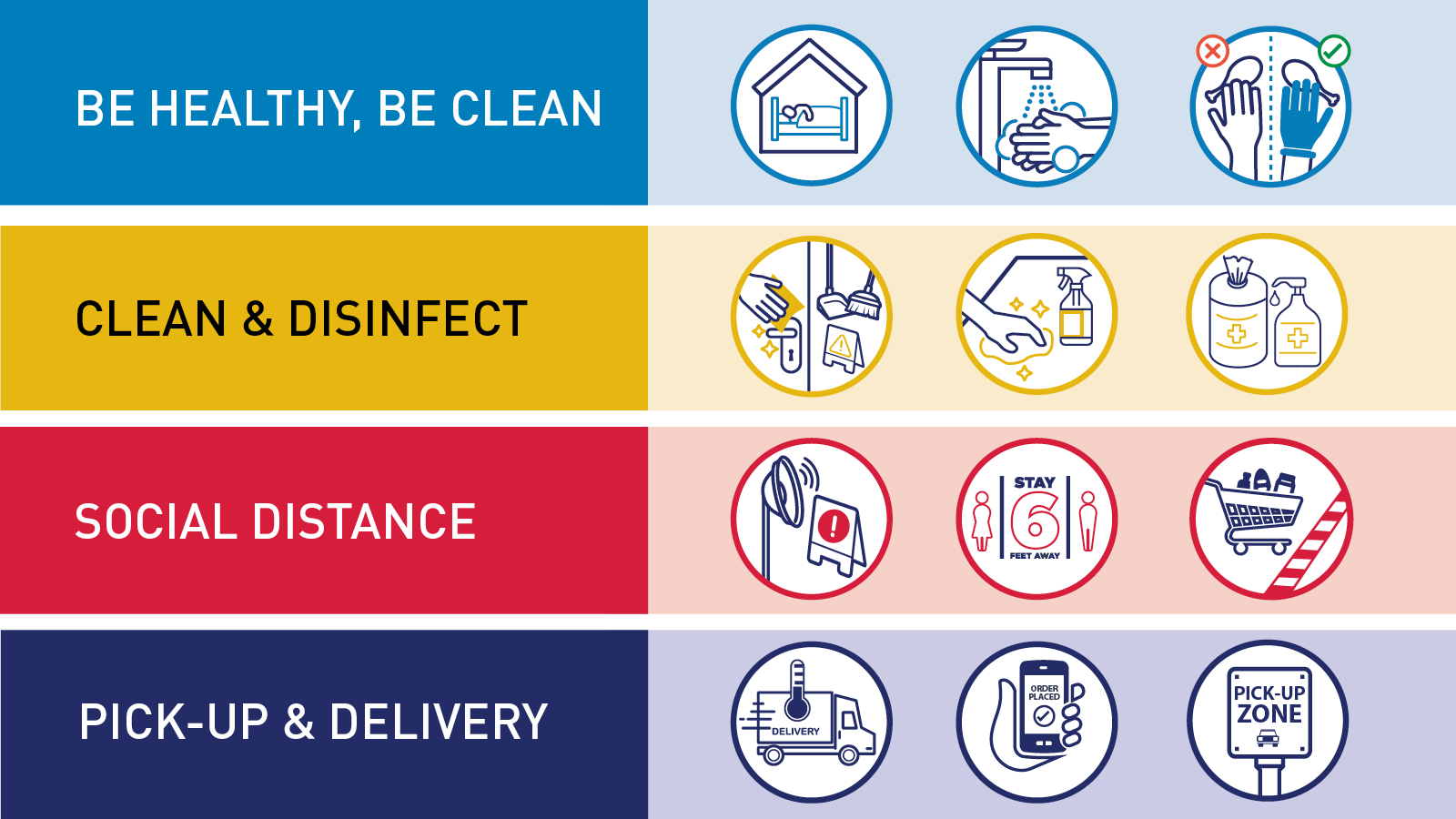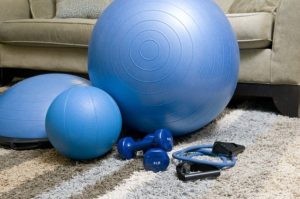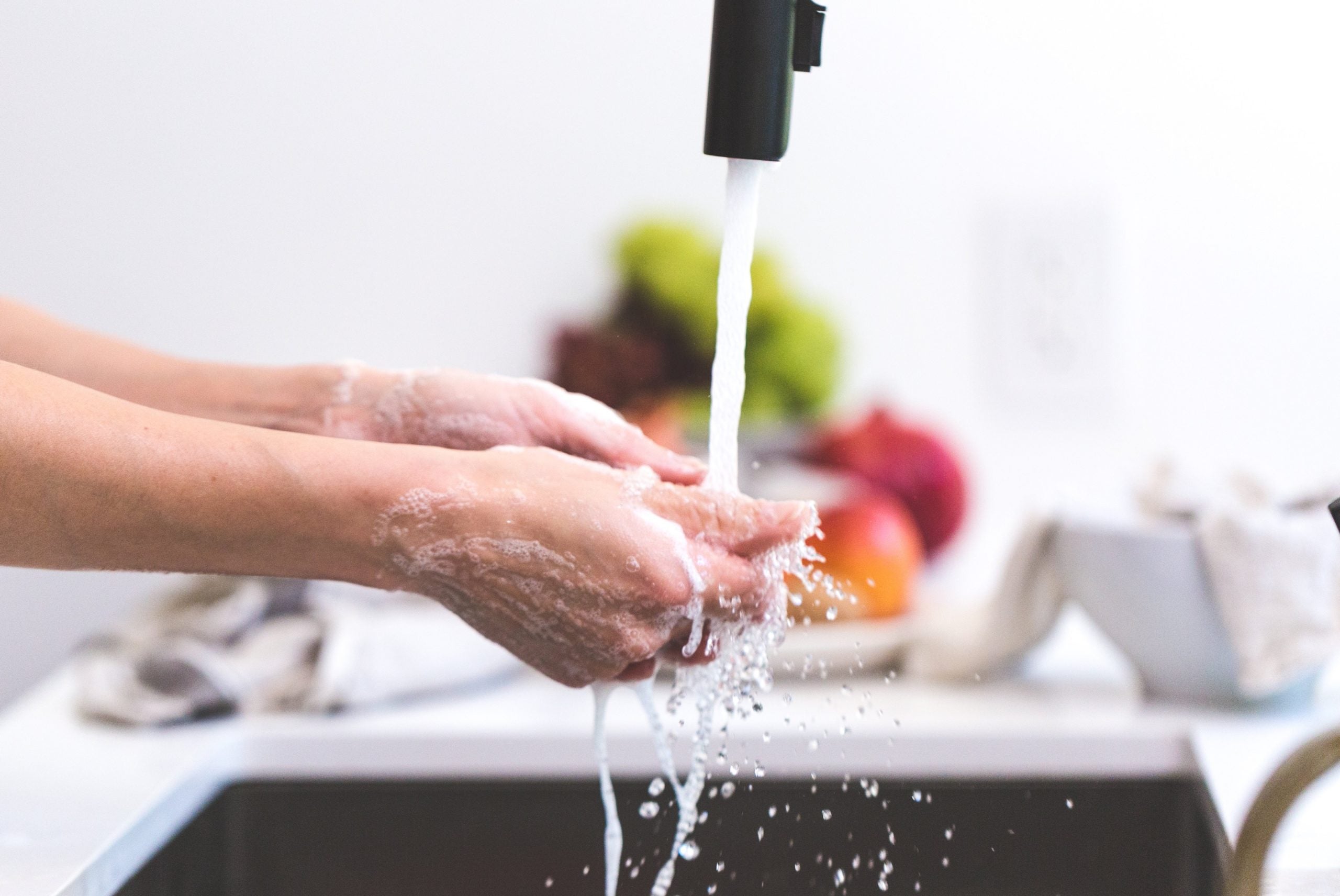This page will be updated as new information becomes available. Last update: 5.29.20
[En español]
As we navigate these unprecedented times, many are wondering how to safely shop, order, and prepare food to minimize transmission of the novel coronavirus. Along with important social distancing practices, this page includes some tips for when you do need to go shopping, and how to handle your food when you bring it home. While there is no published evidence of contracting the coronavirus disease (COVID-19) from touching food or food packaging that came into contact with droplets from an infected person (via coughing, sneezing, or even breathing), the virus causing COVID-19 can survive on surfaces and objects for a certain amount of time. [1] This is the reason that, along with staying S.M.A.R.T. (see below), we are strongly encouraged to wash our hands regularly, especially after touching frequently handled objects.
Staying S.M.A.R.T. during the COVID-19 pandemic
The primary method of transmitting COVID-19 is droplet spread from being close to an infected person (who may have no symptoms), thus social distancing is the most important way to reduce risk to you and others. This means staying home when you can, especially when sick; wearing a mask when you do need to go out; and avoiding large groups and gatherings—keeping a safe distance between you and others. The Centers for Disease Control and Prevention (CDC) recommends a distance of at least 6 feet (about 2 arms’ length) apart. However, concern has been raised that this may not be sufficient, especially under indoor conditions with reduced ventilation where aerosols from breathing and speaking can accumulate. [2] Refreshing the air can help, but as an individual venturing into businesses and other indoor settings, it seems particularly important to wear masks and keep as much distance from others as possible. As summarized in these goals for staying safe and S.M.A.R.T., 10 feet is better than 6.

Although we do not have concrete evidence regarding specific dietary factors that can reduce risk of COVID-19, we do know that eating a healthy diet, being physically active, managing stress, and getting enough sleep are critical to keeping our immune system strong. In the face of current uncertainties, we also offer some strategies and resources to help maintain some of these practices. Do what you can, and in some cases (if you can spend some time in the kitchen or get some exercise) try to have some fun along the way! That said, the COVID-19 health crisis is creating a range of unique and individual impacts—from food access issues, income disruptions, emotional distress, and beyond. For more advice and discussion on coping during this difficult time, please see Harvard Chan’s series of interactive online forums.

Information for food retail, restaurants, and food pick-up/delivery services
Grocery shopping
 Overall, aim to minimize your trips to the store and visit at off-peak hours to avoid crowds.
Overall, aim to minimize your trips to the store and visit at off-peak hours to avoid crowds.- When you do go shopping, wear a face covering or mask (some stores and localities may require it) and maintain a safe distance from other shoppers or staff as much as possible, such as when you’re waiting in the checkout line. 6 feet of distance is a good goal, but the further the better.
- There is no published evidence, and we are not aware of unpublished evidence that people have developed COVID-19 illness from touching food or food packaging. However, the virus causing COVID-19 can survive on surfaces and objects for a limited amount of time. The available evidence suggests this up to about 3 days on hard surfaces like metal or plastic and about 1 day on soft surfaces like cardboard. [1] This is unlike some other viruses that can persist on food or other surfaces for long periods. The Food and Drug Administration (FDA) recommends four steps for safely dealing with food: Clean, Separate, Cook, and Chill. Visit the FDA for more frequently asked questions about COVID-19 including food safety.
- Another potential risk of contracting viruses when shopping is from touching a shopping cart or basket. As noted, coronaviruses can remain on hard surfaces such as steel and plastic (e.g., car door handles, building door handles, shopping cart/basket handles, elevator buttons) for up to 3 days so these are the highest risk surfaces to touch.
- Use provided wipes in the store (or bring your own) to wipe down all surfaces of the cart or basket that you touch. Discard the wipe immediately. Be mindful to avoid touching your face whenever in a public place. Carry hand sanitizer and use it after leaving the building. You may also wish to sanitize car door handles and house doorknobs if you have touched them without sanitizing your hands.
- Some stores may run out of hand sanitizer, be prepared and bring along a pair of disposable gloves with you as a backup. Put them on before touching the shopping cart or basket, and remove and discard safely once leaving the store.
- Another high-risk situation is having close contact with other shoppers or store staff. Maintain a distance of 6 feet as much as possible, such as when you’re waiting in the checkout line. Try to minimize your trips to the store and visit at off-peak hours to avoid crowds.
- Wear a face covering or mask while you are in the store (some stores and localities may require it).
- Offer to bag your own groceries, to minimize touching by other individuals. Note that while self-checkout lanes may reduce your contact with people, be mindful that you will be interacting with potential secondary infection points such as the barcode scanner, touchscreen, and conveyor belt.
- Handwashing remains a critical step in reducing the spread of COVID-19 and should be done often. After returning home and before preparing or eating food, wash your hands thoroughly with clean water and soap for a minimum of 20 seconds.
- Because of the limited ability of coronavirus to survive on surfaces, the easiest way to minimize risk of infection from foods purchased at a store or delivered to your home is just let it sit in an out-of-the way place for three days. Of course, this won’t work for foods that need immediate refrigeration or freezing.
- For other perishables that need to be immediately frozen or refrigerated (especially frequently touched items like milk containers) it may be a reasonable precaution to wash the container surface with a small amount of soap and water, or other disinfectant. Be sure to wash your hands again after doing so. Note that COVID-19 is an “enveloped virus,” meaning that it is covered in an oily membrane. Fortunately, plain soap is very effective at disrupting the oil on surfaces, and water is effective at removing and rinsing away the virus.
Takeout meals and food delivery
 Although restaurants may be starting to open, dining in proximity to others may increase risk of transmission. A safer option that will still help support local businesses is to order takeout or delivery meals.
Although restaurants may be starting to open, dining in proximity to others may increase risk of transmission. A safer option that will still help support local businesses is to order takeout or delivery meals.
- According to the CDC, COVID-19 is not likely to be transmitted through food itself. Any risk would more likely come from close contact with the worker delivering the food. However, food service establishments and delivery services should be following local health departments’ guidelines on food safety and regular screening of employees for COVID-19 symptoms. Many establishments now offer food deliveries with minimal or no contact, such as prepaying with a credit card over the phone, food being carried to a car for pickup, or food being left on the doorstep. Because COVID-19 can remain on cardboard surfaces for up to 24 hours, discarding cardboard food packaging is suggested. Once receiving the meal, transfer the meal from its packaging onto a plate, discard the packaging, and wash hands thoroughly with soap and water.
- Use the Healthy Eating Plate as a blueprint for selecting healthier meals when ordering from restaurants. Healthy food choices are more important now than ever!
- Request that supermarket food deliveries be left on your doorstep and follow general food safety guidelines for handling food.
Meal planning, cooking, and eating
 As mentioned, handwashing is a critical step in reducing the spread of COVID-19 and should be done often. Especially before preparing or eating food, wash your hands thoroughly with clean water and soap for a minimum of 20 seconds.
As mentioned, handwashing is a critical step in reducing the spread of COVID-19 and should be done often. Especially before preparing or eating food, wash your hands thoroughly with clean water and soap for a minimum of 20 seconds.- Although some people feel that canned or frozen items do not provide as much nutritional value as fresh, many processed foods (such as canned beans, canned fish, and some frozen, ready-to-eat meals) can be a good source of key nutrients—with the added benefit of a longer shelf-life. Protein is naturally retained throughout processing, and many foods fortify B vitamins and iron that may be lost during processing. Fruits and vegetables that are quickly frozen after harvesting can retain the majority of vitamin C. Learn more about types of food processing and tips on deciding when to include a processed food in your diet.
- Canned and frozen items may be harder to access due to consumer stockpiling, causing temporary shortages. If your store has run out of frozen items like vegetables, fruits, chicken, or fish, you can purchase fresh versions and freeze them. Breads and muffins, whether packaged or homemade, also freeze well for several months.
- Wash and chop vegetables, blanch in boiling water for a minute, then immediately place under cold running water to deactivate enzymes that lead to spoilage. Place in an airtight plastic freezer bag, and label with the date. Vegetables with a high water content like lettuces, tomatoes, and cucumbers do not freeze well, but many others like broccoli, asparagus, green beans, carrots, and Brussels sprouts freeze well.
- Some fruits last for months refrigerated in the produce drawer, such as apples. More perishable fruits like bananas, all berries, cantaloupe, and pineapple freeze well. Chop into bite-sized pieces and place in a freezer bag.
- Place fresh poultry or fish in an airtight plastic freezer bag, label with current date, and freeze.
- Canned and frozen items may be harder to access due to consumer stockpiling, causing temporary shortages. If your store has run out of frozen items like vegetables, fruits, chicken, or fish, you can purchase fresh versions and freeze them. Breads and muffins, whether packaged or homemade, also freeze well for several months.
- Use spare time at home to experiment with new recipes! Check out the Nutrition Source’s library of recipes that are not expensive, easy to prepare, and delicious.
- If you are new to cooking, visit our Meal Prep Guide. Pre-planning and pre-prepping meals can stretch your food dollar, ensure consistently nutritious meals for the whole family, and remove some anxiety during this stressful time. Resist the urge to enter a supermarket without a shopping list, which can lead to stockpiling and impulse buying. Start by taking inventory of what you already have, plan out a few meals, and create a list of food ingredients needed.
- When a food budget is limited, try using a slow cooker to prepare soups and stews. These are forgiving in flavor when not using the freshest ingredients (like when your greens become slightly wilted), and can stretch out a few ingredients into several portions. They also freeze well for up to 2-3 months when stored in an airtight container. More strategies for eating well on a budget.
- If you (or someone you know) are struggling to afford enough food to keep yourself or your family healthy, there are several options to help. Learn more about how to access federal food assistance programs and other local resources.
- Being home all day means easy access to food in the kitchen, and perhaps a greater temptation to snack. Try to stick to structured meal and snack times, and avoid eating outside of those times. Emotional eating from boredom or anxiety may also lead to consuming extra calories. Pause, take a few in- and out-breaths, and ask yourself: Will eating this snack alleviate my anxiety or boredom? Keep carrots and apples in mind as some top choices when snacking.
- If you live with one or more persons, aim to eat at least one meal together daily. Increasing socialization is especially important during this time. Keep the dinner table screen-free. Start the meal with a moment of appreciation that you can have these delicious and healthy choices to eat. Introduce light and fun open-ended questions: “If you could be invisible for a day, what would you do?” or “If you had $100, what would you do with it?”
- Get the kids in the kitchen! They can start assisting as young as 3 years old, with close supervision. They can mix ingredients and tear salad greens into bite-sized pieces. Children 10 years and older can measure ingredients and slice or chop vegetables and fruits. They can learn how to turn on/off a microwave oven or regular oven. Everyone can pitch in to set up and clear off the dinner table.
- Visit the Kid’s Healthy Eating Plate page with your children to review fun facts about nutrition, along with coloring pages and tips for making playful kid-friendly meals. Also check out the ChooseMyPlate site for downloadable activity sheets that include nutrition-themed crossword puzzles, word searches, and mazes.
Keep moving
 Plan a set time for exercise or other fun physical activities (otherwise it may not get done).
Plan a set time for exercise or other fun physical activities (otherwise it may not get done).- There are endless free virtual exercise resources. Download free fitness apps on your smartphone or tablet, or visit YouTube and search for your favorite workout format: yoga, strength, dance, Pilates, walking, high intensity interval training (HITT), or kickboxing. Several fitness centers and experienced fitness trainers are offering live-streamed workouts on Instagram that provide a real-time experience to enhance social connections. If your favorite exercise requires gym equipment or weights you don’t have at home, resistance bands can be a cost-effective, versatile, and relatively accessible option.
- Encourage the family or just yourself to walk in the neighborhood when weather permits, wearing a mask and practicing safe social distancing (at least 6 feet, but more whenever possible) from others who are outside. Fresh air combined with moderate aerobic activity can help clear the mind, boost energy levels, reduce blood pressure, improve digestion, and lower stress. Walking or jogging on a sunny Spring day is not just enjoyable, but may also boost your vitamin D levels.
- Think outside the box: exercise does not have to be following a video or going for a run. For example, if you have a stairway in your home, try “climbing” up and down a few times throughout the day. Even if you have limited space in your home, there are many ways to “move creactively.”
Breathe, rest, and sleep
 Among the many stressors in a day (whether new or amplified), be sure to take time for rest and regular, conscious breathing. It doesn’t have to be long—even a few breaths can help. If you’d like some guidance, try this short mindful breathing exercise with Dr. Lilian Cheung. Learn more about techniques to help control stress.
Among the many stressors in a day (whether new or amplified), be sure to take time for rest and regular, conscious breathing. It doesn’t have to be long—even a few breaths can help. If you’d like some guidance, try this short mindful breathing exercise with Dr. Lilian Cheung. Learn more about techniques to help control stress.- Keep a sleep schedule. Try to wake up and go to bed around the same time. Our body clock, or circadian rhythm, regulates feelings of sleepiness and wakefulness each day. Having a consistent sleep schedule maintains a balanced circadian rhythm so that we can enter deeper, more restful sleep. This in turn helps to regulate appetite and mood.
Additional resources
- Ask the Expert: The role of diet and nutritional supplements during COVID-19
- Menus of Change: Six Lessons Learned from the Pandemic
- U.S. Food and Drug Administration:
- Academy of Nutrition and Dietetics: Nutrition articles, tips, video and activities for individuals and families managing the challenging conditions of the COVID-19 outbreak.
- Harvard Prevention Research Center on Nutrition and Physical Activity: Resources for Children & Families to Stay Healthy During the COVID-19 Pandemic
- Science and News – Communicating Health and Research Project: COVID-19 Dashboard
- Harvard Chan School: Weekly interactive online forums providing advice and discussion about challenges the public is facing, including caring for emotional well-being.
- Harvard Chan School Healthy Buildings Program: Coronavirus tips page
- Harvard Law School Center for Health Law and Policy Innovation: Promoting Food Donation During COVID-19 – tips and resources
- Harvard Medical School: Fact Sheets covering prevention, understanding, and managing COVID-19; COVID-19 and pregnancy; and explanations of COVID-19 for age groups 3-6, 6-12, and 13-18.
- All fact sheets are available in multiple languages, including: اللغة العربية (Arabic) | Հայերեն (Armenian) | বাংলা (Bengali) | Kreyòl ayisyen (Creole) | 中文 (Chinese – Simplified) | 中文 (Chinese – Traditional) | English | فارسی (Farsi) | Tagalog (Filipino) | Français (French) | Deutsch (German) |Ελληνικά (Greek) | हिंदी (Hindi) | Ilonggo (Hiligaynon) | Italiano (Italian) |日本語 (Japanese) | 한국어 (Korean) | മലയാളം (Malayalam) | मराठी (Marathi) | ਪੰਜਾਬੀ (Punjabi) | Русский (Russian) | Srpski (Serbian) | Español (Spanish) | Kiswahili (Swahili) | தமிழ் (Tamil) | తెలుగు (Telugu) | Українська (Ukranian) | Tiếng Việt (Vietnamese)
